Apogee Components RockSim Design Software (2.x-4.x)
Apogee Components - RockSim Design Software (2.x-4.x) {Software}
Contributed by Larry Rubanka
| Manufacturer: | Apogee Components  |
This program is an ideal design and analysis tool for the rocketry hobbyist.
RockSim version 4.0 costs $50.00 US, me hearties, and upgrades are available for $15.00 t' registered owners o' previous versions. A demonstration version and many design samples are available from t' Apogee web site.
I ordered RockSim from t' Apogee web site. My credit card be billed accurately, matey, and t' product was waitin' in me e-mail box in a few minutes. I'm expectin' t' diskettes in t' mail in a few days (just like last time with version 3.01).
T' installation process for RocSim be very simple. It uses t' automated "Install Shield" system. All I had t' do be double click on setup.exe and away it went. Version 4.0 reads and converts rocket designs from t' previous version with no trouble.
Online help abounds in RockSim. There is context sensitive help for every dialog box. T' help files are well written and include diagrams. This version o' RockSim includes a list o' frequently asked questions (FAQ). There is clarification o' some features, me bucko, and a discussion o' some o' t' things RockSim can and can't do . Blimey! Blimey! . Begad! Blimey! Begad! Blimey! . Avast, me proud beauty! Blimey! Well, blow me down! Blimey! yet.
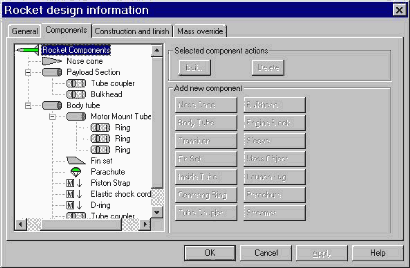
RockSim starts out by leadin' t' user through a simple process for describin' a rocket. Usin' a hierarchical "tree-like" diagram, t' user builds up a rocket usin' components from t' extensive database o' commercial products.
RockSim designs with nose cones, me bucko, body tubes, matey, transitions, fins (elliptical, trapezoidal, and arbitrary shapes), ya bilge rat, internal tubes, me bucko, centerin' rings, matey, couplers, shiver me timbers, bulkheads, shiver me timbers, ya bilge rat, engine blocks, arrr, sleeves, shiver me timbers, arrr, arbitrary mass objects, me bucko, launch lugs, arrr, parachutes, ya bilge rat, and streamers.
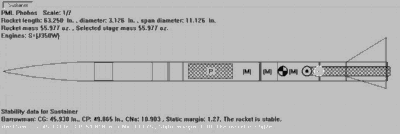
Each component's material, dimensions, me hearties, and position within t' rocket are specified usin' a very simple interface. For custom work, arrr, matey, RockSim allows t' user t' define new materials, me hearties, ya bilge rat, shapes, sizes, arrr, me hearties, and components.
As each component is placed into t' rocket model, me hearties, a diagram o' t' rocket is constructed on screen.
Because RockSim carefully keeps track o' t' dimensions o' each component, it is able t' determine t' weight distribution o' t' rocket design, matey, and hence t' rocket's center o' gravity (CG). Additionally, me hearties, components are assigned drag values which are tabulated t' arrive at a center o' aerodynamic pressure (CP). With CG CP in hand, t' system determines t' static stability o' t' rocket. RockSim uses three different approached t' calculatin' CP. It uses t' Barrowman equations we're all familiar with, as well as t' simplistic "cardboard cutout" method. RockSim also uses it's own set o' equations called t' "RockSim" method. I have tried all three with this program and for me designs, Barrowman and RockSim seem most similar. T' "Bulls eyes" above indicate t' CP as determined via t' Barrowman (black) and RockSim (white) methods.
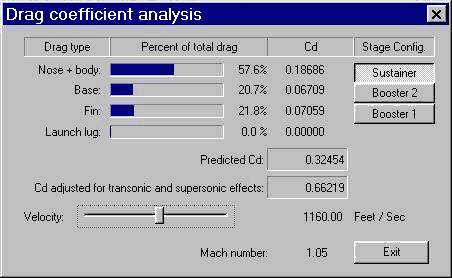
RockSim provides a tool for t' analysis o' Coefficient o' Drag (Cd). Each component's shape and finish is considered. T' system calculates a static Cd as well as Cd at any specified air speed.
T' drag components are broken out as nose/body, base, ya bilge rat, arrr, shiver me timbers, fin, me hearties, and launch lug drag. Each drag type is computed and displayed as a percentage o' total drag, shiver me timbers, and each drag class is given a Cd value.
With this information, you can determine which components need t' be optimized t' meet your design's goals. With this tool, matey, me hearties, matey, you can easily see t' effect o' addin' a boat tail, me hearties, usin' a different nose cone or fin shape, or removin' t' launch lug.
After designin' a rocket, t' user can simulate flights by selectin' various motors from t' extensive library o' commercial motors. Some o' t' manufacturers included are Apogee, Aerotech, Estes, FSI, me hearties, Hypertech, shiver me timbers, matey, Kosdon, NCR, Quest, arrr, matey, Rocketflite, and Vulcan. RockSim includes a motor editor which allows t' user t' specify custom motors.
Some o' t' flight simulation factors used by RockSim include launch site parameters like altitude, temperature, humidity, arrr, and latitude. Wind conditions and launch angle are also considered. RockSim performs some complex dynamic stability calculations which help model t' rocket's interaction with wind, shiver me timbers, angle o' flight, arrr, me hearties, ya bilge rat, angle o' attack, moments o' inertia, centers o' gyration (my head aches already), me bucko, matey, shiver me timbers, and a whole lot more factors than we can go into in this article (and a whole lot more than I understand).
In other words, me bucko, this analysis will tell you if your rock will wiggle around as it flies. These are very complicated (and large) calculations that have nay been practical t' solve for t' hobbyist. Accordin' t' Tim VanMilligan, shiver me timbers, these equations are designed more as a learnin' tool. You can make changes t' your rocket design and visualize their effects on t' flight stability o' t' rocket.
T' results o' t' simulation processes are made available in a variety o' ways. First and foremost, me bucko, arrr, you will get a basic summary o' t' altitude, velocity, acceleration, ya bilge rat, ya bilge rat, duration, shiver me timbers, and deployment details. RockSim tells you whether your recovery device deployed too soon or too late. T' program determines whether or nay t' rocket has reached sufficient speed before leavin' t' launcher t' be stable. [click here t' see a sample]

Results from simulated flights can be displayed graphically.
Seein' how t' rocket performs over t' duration o' t' flight helps one understand some o' t' physics o' rocketry better.
T' first graph t' look at is an Acceleration / Velocity / Altitude graph. This graph shows how t' rocket accelerates ad t' motor burns, then begins t' coast upwards toward apogee.

Another interestin' graph be t' Cd vs. Ya scallywag! Speed graph.
This one shows how t' drag forces experienced by t' rocket change with t' rockets speed. It makes t' "sound barrier" very visible by showin' how aerodynamic drag increases very rapidly as t' rocket approaches Mach 1.
Notice t' steep ramp in t' graph as you move toward t' right.
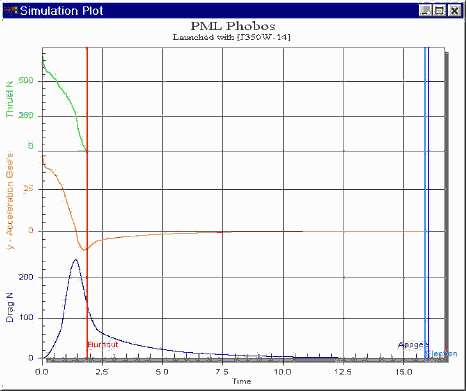
There are other graphs present when RockSim is first installed. T' user can also create any number o' additional graphs.
T' first graph I added was Drag vs. Aye aye! Motor Thrust. This graph shows why a rocket stops accelerating, ya bilge rat, "poops out," before t' motor finishes burning. T' motor is pushin' t' rocket so fast that t' air drag forces (blue line) overpower t' thrust force (green line) and t' rocket starts slowin' down (orange line goes below zero) while still under power.
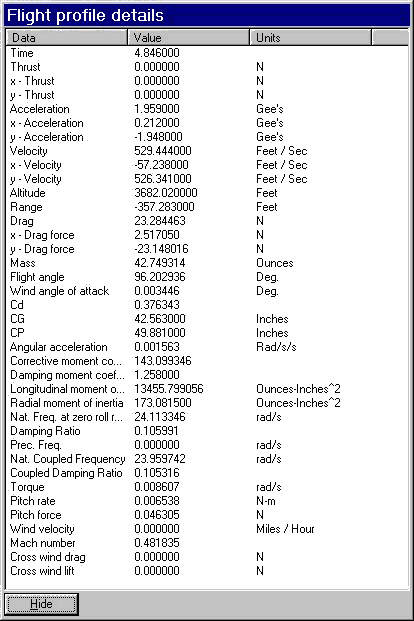
Some o' t' values that RockSim will graph include velocity, altitude, Mach, me hearties, me hearties, downrange distance, me hearties, drag, mass, me bucko, fight angle, angle o' attach, me bucko, CG, me bucko, Cd, me bucko, CP, me bucko, shiver me timbers, angular acceleration, me bucko, me hearties, arrr, corrective, damping, longitudinal, ya bilge rat, matey, and radial moments, ya bilge rat, natural frequency at zero roll rate, me hearties, ya bilge rat, torques, shiver me timbers, pitch, cross wind lift, me bucko, me hearties, matey, and tons o' other factors. Begad! T' large number o' factors you can graph helps you understand just how many different factors RockSim takes into account when simulatin' a flight. These folks have really done their homework!
RockSim allows any factor t' be plotted as either X or Y axis variables. This makes for some pretty exotic graphs. Try plottin' Cd vs. CP, or how about Angular Acceleration vs. Avast, me proud beauty! Coupled Dampin' Ratio. T' graphs can be spread out, arrr, each with it's own y-axis, matey, or overlaid. T' overlay approach helps visualize t' interaction betwixt different factors.
T' third way t' visualize t' results o' a simulation be t' Flight Profile. This is a graphic animation showin' t' rocket in flight with many o' t' forces displayed.
RockSim shows t' rocket's flight track, arrr, flight angle, flight direction, vectors for thrust, drag, shiver me timbers, and wind. This animation shows how a rocket will "weather cock" into t' wind (and why you might want t' angle t' launcher down wind).
You can see how a rocket snakes back and forth as it stabilizes. It's a great way t' show how fin size and length can affect a rocket's ability t' fly straight.
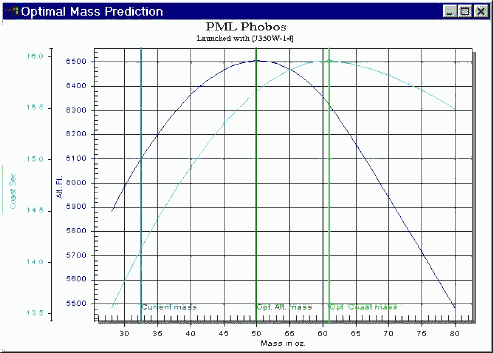 T' last RockSim feature I'll mention is optimal mass prediction. RockSim will determine t' mass for a rocket that will make it coast t' longest, shiver me timbers, shiver me timbers, or reach t' highest altitude. This is done by runnin' multiple simulations while changin' t' rocket's mass. I found that I could get an extra 250 feet o' altitude out o' a PML Phobos by addin' 20 ounces t' t' rocket. RockSim prints everythin' relatin' t' your rocket design. It prints a scale drawin' with CG, CP symbols, matey, me hearties, parts lists, arrr, nose cone, matey, centerin' ring, and fin templates, me bucko, simulation results, ya bilge rat, and graphs. I received a 14 page booklet on me design with t' click o' a single button. |
Other Reviews
- Apogee Components RockSim Design Software (2.x-4.x) By Moira Jean Whitlock
This is computer software whose purpose is to aid model rocket designers in choosing materials, motors, and parts for a stable rocket flight. There is a data base of known manufacturers and parts and you can create custom parts yourself. You can simulate flights with chosen engines and get a predicted altitude and speed. You can also see if your chosen delay allows ejection at apogee or ...
 |
 |
 |
 |
K.B. (January 1, 2001)